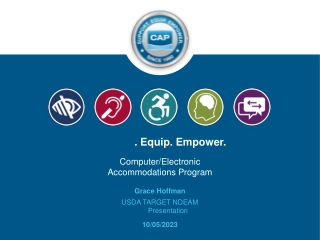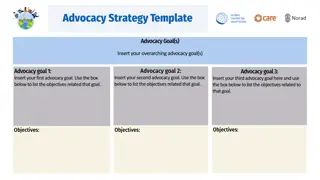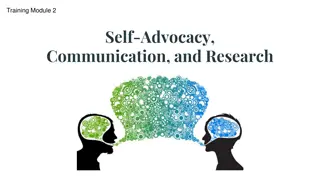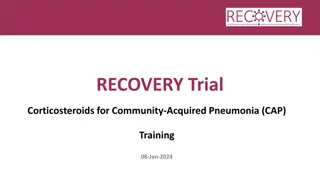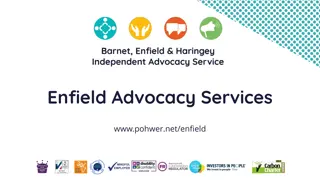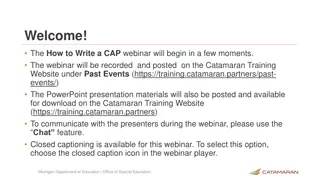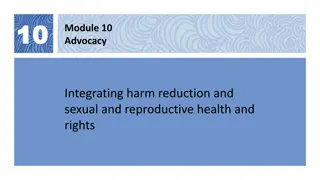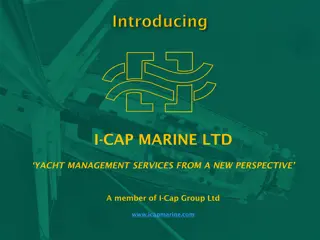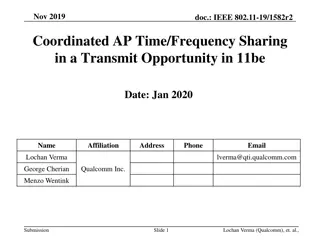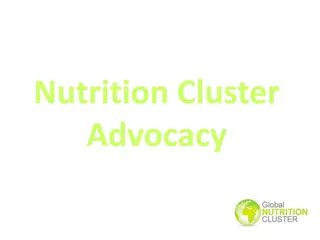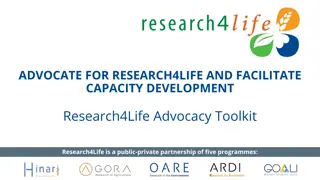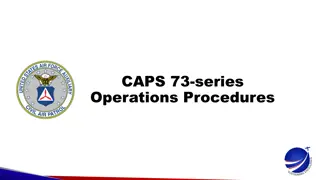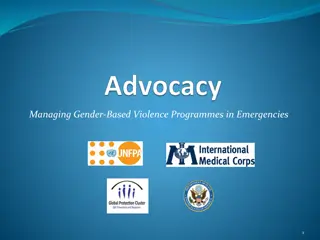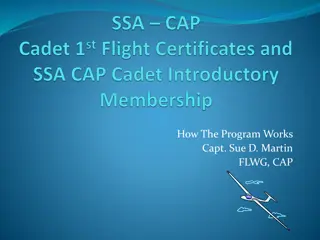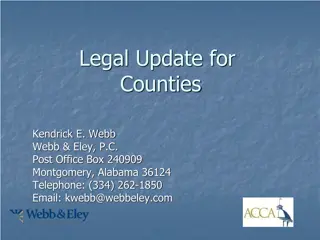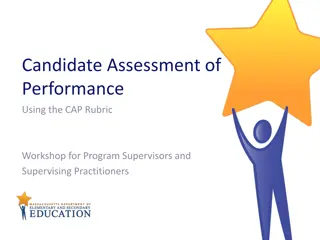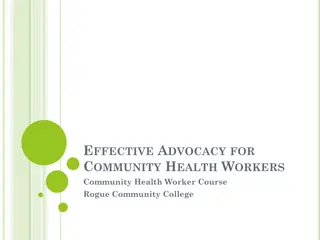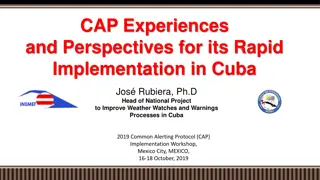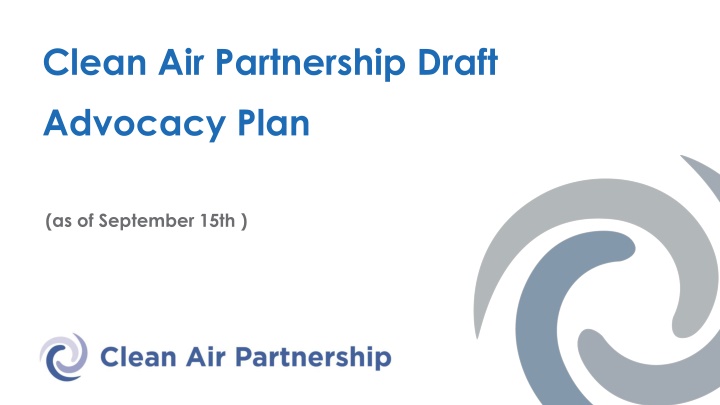
Driving Advocate Action for Clean Air
Clean Air Partnership (CAP) envisions sustainable, healthy, and resilient Canadian communities through advocacy efforts focusing on improving air quality, advancing sustainable transportation, climate action, and community resilience. The draft Advocacy Plan outlines strategies to engage board members, connect with targeted audiences, and collaborate with government entities effectively. CAP's strategic goals emphasize municipal environmental leadership, policy transformation, and energy efficiency to achieve a low-carbon economy.
Download Presentation

Please find below an Image/Link to download the presentation.
The content on the website is provided AS IS for your information and personal use only. It may not be sold, licensed, or shared on other websites without obtaining consent from the author. If you encounter any issues during the download, it is possible that the publisher has removed the file from their server.
You are allowed to download the files provided on this website for personal or commercial use, subject to the condition that they are used lawfully. All files are the property of their respective owners.
The content on the website is provided AS IS for your information and personal use only. It may not be sold, licensed, or shared on other websites without obtaining consent from the author.
E N D
Presentation Transcript
Clean Air Partnership Draft Advocacy Plan (as of September 15th )
Advocacy Plan Board Considerations Does this advocacy plan approach make sense to you? Do you see gaps in CAP s draft Advocacy Plan? What assets/supports can CAP Board members provide to introducing/connecting CAP with targeted audiences (the underlined bullets link to the staff directory for each of the departments) Reach out to Don Huff from ECO Strategy for expert advice/input Progress reports to Board on outcomes of the prioritized actions
General Approach Prioritize possible advocacy actions (there is more to dos than can realistically be achieved given staff time constraints) Identify what role board members can play or which connections they may be able to help with Identify key asks from CAP and Ontario municipalities (in SP Implementation Plan) Reach out to government contacts to better identify their priorities and opportunities for Ontario municipalities to work together more and increase opportunities for sharing across levels of government Identify alignment between the above 2 actions, communicate that alignment to target audience
CAP Vision and Mission Vision: Canadian communities are sustainable, healthy, and resilient. Mission: Clean Air Partnership (CAP) enables communities to improve air quality, advance active and sustainable transportation options, take bold climate action, increase community resilience to climate impacts and accelerate the transition to a low carbon economy. We convene networks, lead research and knowledge transfer, and catalyze transformative action.
CAP Strategic Goals Value Proposition Strategic Goals Advancing Municipal Environmental Leadership & Accountability Policy transformation Climate Change /Sustainability Integration into Municipal Decision Making Energy retrofits Low Carbon & Active Transportation Reducing Carbon from New Buildings and Advancing Building Code Maintaining a capable, resilient, knowledgeable organization Program implementation and scale up Innovative Research
CAP Advocacy Plan To increase ability to advance Strategic Directions and mission, CAP will need to expand spheres of influence, deepen existing partnerships and cultivate new partnerships. This draft powerpoint will serve as the workplan for these CAP advocacy and partnership development efforts.
Advocacy Objectives 1. Key relationships CAP should be developing at both the provincial and federal level that would better enable CAP to achieve mission. Leverage connections and advocacy experience within Committee and Board members towards supporting CAP s advocacy Plan. Goal: How to increase CAP s municipal representation legitimacy with federal and provincial governments (At present FCM and AMO lead this work. CAP represents a specific sub-set of that municipal network. Ontario municipalities that have higher climate ambitions than the wider FCM and AMO networks. How do we increase legitimacy of our representation of those municipalities? How do we inform FCM/AMO of these efforts? Action: Reach out to federal and provincial ministries to better understand their priorities. Additional Coordination with Communications Committee: Develop CAP messaging that would better enable our mission and programs to align with the strategic priorities of targeted stakeholders. This will enable CAP to increase non municipal government stakeholders aware/involved in our work. Additional non-government partnerships that would be of most value to helping CAP serve its municipal partners. 2. 3. 4. 5. 6. 7.
Policy/Action Priorities Municipal Climate Lens Efforts (that don t fit into present federal requirements and municipal capacity to operationalize a climate lens) Model Building Code implementation and capacity building Bringing federal efforts/actions/learnings to green government to municipal audience Joint municipal pilot testing/sharing across municipal network to build momentum. Building municipal awareness of federal government actions to identify collaboration/sharing opportunities.
CAP Federal Government Relationship Development
ECCC Ministers Office Do any board members have relationships with any of the Minister s staff to help make introductions to introduce them to CAP? The general trend is feds work with municipalities through FCM and if that is the case what would be the goal we have re introducing Minister s staff to CAP? What is a realistic outcome for this effort?
Which Divisions Should be Prioritized? Pan-Canadian Framework Implementation Office Pan-Canadian Framework Horizontal Policy & Coordination Ontario Region Associate Regional Director General Do CAP Board members have contacts in any of the above offices that may be friendlies for CAP and help us navigate this labyrinth?
NRCan Greening Government Services & Energy Use Data To get them to share what they are doing with the municipalities to increase sharing across governments Energy and Environment Policy Division Office of Energy Efficiency Housing Programs Do CAP Board members have contacts in any of the above areas that can help us with introductions and navigating the departments and their various programs?
Top Goals for NRCan Outreach Get a better understanding of possible funding streams for CAP and municipalities Get NRCan to bring their programs/expertise to municipalities Increase interactions between NRCan staff and Ontario municipalities
Federal Climate Adaptation Landscape Map out federal Climate Adaptation Landscape Identify key contacts who can bring an understanding of federal efforts and priorities to municipalities. Have been bringing federal climate change resilience programs to municipalities and providing them input on municipal input Ex. Canadian Centre for Climate Services; Climate Atlas of Canada
Minister Level Outreach Efforts Review CAC consultation Submissions summarize and identify key asks to the different ministries (MECP, MMAH, MENDM) Schedule meetings with Ministers staff to share top input with them and try and advance more conversations between their Ministries and Ontario municipalities. It would be ideal to bring staff and municipal politicians' top priorities together.
Minister Level Outreach Efforts Take top level recommendations from municipal staff consultations and bring to Ontario Climate Caucus for their input/buy-in/prioritization Identify actions that the Ontario Climate Caucus would prioritize for advancement Send letters with top issues to Ministers and their staff to schedule conversations between Ontario Climate Caucus and Minister staff.
CAP Provincial Staff Outreach While also working at the Minister level would also be reaching out to the provincial staff who would be able to provide input on provincial actions/input to municipal asks.
Climate Resilience Climate Change and Resiliency Division (reach out to Alex Wood-Assistant Deputy Minister; Heather Pearson, Director and their teams) Reach out to Climate Risk Institute who got the Climate Change Impact Assessment contract with Province to better understand the scope of their contract.
Climate Change Mitigation Branch To get a better sense of their implementation plan for the Environment Plan and opportunities to increase collaboration between municipalities and the MECP CAP has connections with Policy Coordinators who can help us better understand ministry priorities See link above for staff directory
Climate Change Programs and Partnership Branch CAP has relationships with two Senior Policy Coordinators who may be able to help us understand their priorities and ability to increase municipal/provincial collaboration See link above for staff within this branch
MMAH Does anyone have MMAH contacts who can help us better understand how to interact with this Ministry? Ex. top priorities: Intergovernmental Relations and Partnerships Branch, Growth Secretariat; Urban Affairs, Building Code
CAP Municipal Advocacy Recruitment of new CAC Municipal Members (& keeping CAC members) Deepening and building new municipal relationships Moving beyond just climate/sustainability staff into departments, senior staff, council Ontario Climate Caucus facilitation/supports
NGO Partnerships Map out present partnerships/collaborations between CAP and other ENGOs How can CAP reach out to new potential partners in the health sector, equity and affordability sector, just transition to improve the inter-sectionality of CAP s work? Forming more partnerships with Climate Caucus and the organizations that are supporting them Traded memberships with CAN RAC and trying to build connections between NGOs and municipalities
Key Actions Keep FCM/AMO informed of federal and provincial actions CAP is advancing? How do we best ensure continued collaboration with FCM/AMO?

